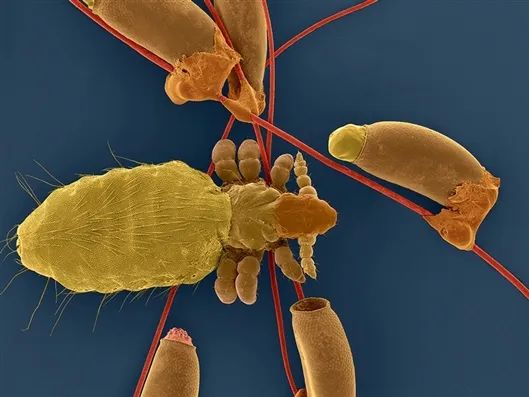The first mammalian of lice is it!
Author:Journal of China Science Time:2022.07.06
Text | Xinyu

A long nose bull lice picture Source: Dennis Kunkel Microscopy/SPL
At least 90 million years ago, the mammals at the time may be very happy because they had no lice on their bodies. But this did not last long.
Today's elephant and an ancient ancestor infected with this tiny skin parasite from a bird, and established a significant but uncomfortable intimate connection between mammals and lice. And this connection has continued until today.
Recently, Kevin Johnson, a biologist at the University of Illinois in the United States, and the co -author conducted a genome research on the "lice tree" on mammals, and found that lice that parasitic on mammals today can be traced back to the extinction of non -bird dinosaurs. Previously, the same ancestor parasitic on mammals. The research results were published in "Nature -Ecology and Evolution" published on July 4.
The story of lice on mammals is rarely told, but in some aspects, it is as dramatic as the story of mammals.
For example, tens of millions of years ago, when seal adapted to living in the ocean, their lice also adapted to become the only true marine insect. Bret Boyd, a biologist in the Federal University of Virginia, pointed out that lice can be evolved very complicatedly with the host.
Lice also has an extraordinary ability. When the opportunity appears, they will change the host. It is this skill to help explain why the lice of seals, Skulls, elephants, and humans seem to be the descendants of the same ancestor.
After checking the genetic data of 33 kinds of lice from all major mammals groups, the Johnson team concluded that lice have been switched between mammalian hosts at least 15 times since the first parasitic of mammals.
The "lice tree" of mammals is difficult to combine together because the host is converted, but this is not the only reason.
Therefore, fixing the "lice tree" has a wider meaning. Vincent Smith, a researcher at Biological Diversity of Biological Diversity of Natural History in the UK, said that the early 20th century biologists used lice to test their ideas on common evolution, and this new study may attract biologists' interest in these extensive evolutionary themes, and and and and of. Look at lice with a new perspective.
"Lice Tree" can also provide important insights for the host conversion, because the origin of some diseases can be explained from other animals from other animals to humans. Johnson believes that any information that can have more in -depth understanding of this mechanism may help people to minimize the opportunity to transmit new diseases to humans.
But this process is complicated. Boyd said that one of the reasons for sucking lice to survive on mammals is that symbiotic bacteria carried by parasitic insects provide them with B -based vitamins that cannot be easily obtained from mammalia.
However, just like lice can be switched between mammals, bacteria seem to be switched between lice hosts.
A few years ago, when the Boyd team was studying the lice on a seal, they found that their symbiotic relationship with bacteria was recently understood.
Boyd believes that lice may lose some ancestors' symbiosis and replace them with new symbiotic bodies, so this is very similar to the host conversion, which reflects the complexity of this relationship.
Related thesis information:
https://doi.org/10.1038/s41559-022-01803-1
"China Science News" (2022-07-06 No. 2 Edition International)
Edit | Zhao Lu
Capture | Zhihai
not

- END -
The moon is busy!Hand in hand to interpret the romance of "Star Moon Same Box"

According to more than ten days after June 16th, before sunrise, Venus, King Star,...
Symposium on Small and Micro -Enterprises in Shijingshan District held

Reporter Wang ChanaRecently, in order to further implement the relevant content of...